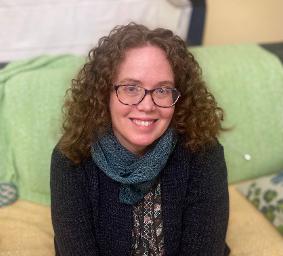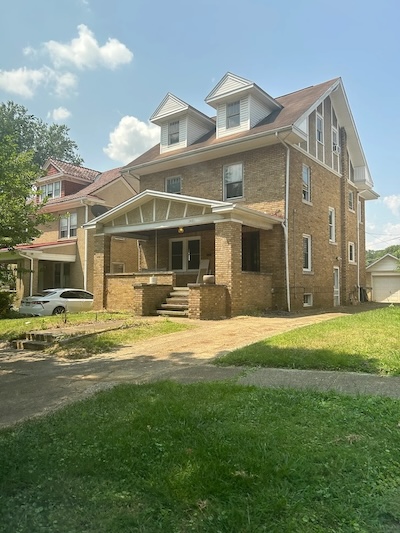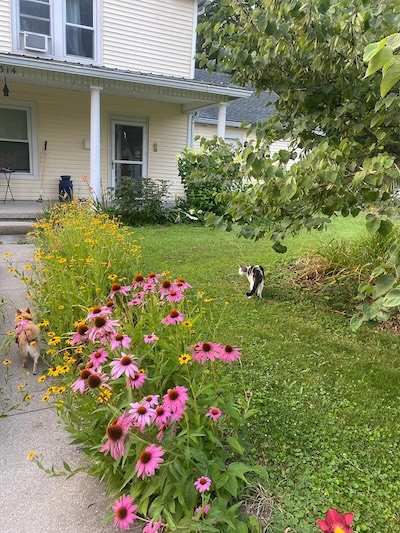As part of the Berea College Appalachian Tour, we visited Huntington, West Virginia. While the college faculty and staff were off learning, I hired an Uber driver and took a tour of the place we used to call home. Home seems too small a word for the way Huntington lives in my heart. Chris and I bought our first home together there, and we started the raising of our family there. Of course, we were adults before Huntington, but it was there we joined a church, where Chris got tenure, where I made my first mom friends, and where I threw myself fully into the life of a place. Huntington is special. When we moved back to Kentucky in 2012, our hearts broke.
I’ve driven through several times in the last decade. Most recently, I haven’t had the heart to drive by our old house. This time, I asked the Uber driver to take me.
This is a story about gardens.
Fifteen years ago, this yard was as full of flowers as my Berea garden. The colors weren’t as varied, because I didn’t have money for flowers. I hadn’t yet mastered the art of succession planting for color through the season. Still, fifteen years ago, this house was framed by daylilies, daisies, iris, and coneflowers. When we moved away, our realtor sent me pictures of the flowers until the house sold.
Today, there’s nothing. No color. No flowers. No sign I was ever there.
The flowers are here in Berea. I mean, the exact ones. I divided plants and dug up enough starts to bring a piece of the garden with me. Even as the full garden bloomed back in West Virginia, I kept the roots alive at our rental house in Berea. When we moved into the house where we live now, I yanked ivy out of neglected beds here and made space for my plants. The flowers have grown and divided so many times now that those self-same plants are in gardens all over Berea. I’ve sent flowers to Atlanta with a coworker, and they’re growing in the Georgia clay.
Yet someday all this summer glory I give to Berea will be gone. Someday, this garden too will look as bare as my Huntington home does today. The rhododendron — planted several owners ago in the 1980s — may last. The rhododendron — a shrub that lived with the dinosaurs — has no known life span. If you keep it trimmed, it can live forever.
I have no illusions about anything else.
Gardens teach us how to live. Gardens in one season teach us how to be born, how to root ourselves in this world, and then how to die. Gardens teach us that nothing lasts.
Digging my hands into the soil, pulling weeds, and dead-heading walk me through fleetingness. It is a comfort and not a comfort to know that the plants from my West Virginia garden live here even though that garden is dead. It is a comfort and not a comfort to watch the Hobson home place irises bloom each spring when the loving hands that tended them first are long gone. My hands pull tubers from the ground and divide them to send them on to new gardens. I keep sharing plants in hopes that they will live on after my own arms, hands, and heart are no more.
There are holly trees all over Berea. Their parents live in our yard and in our neighbors’. Mr. Evans — who grew up next door — remembers his father spreading starts from the tree all over Berea. The tree itself was a gift to his grandfather — a dentist — in exchange for fixing a woman’s teeth. That tree came from the next county over. If you see a holly tree on the ridge in Berea, chances are it comes from the trees here. The trees here are reaching their end after the best part of a century.
I don’t believe in a Garden of Eden, nor in stories of heaven. I do believe that we’ve been tending the soil forever and that we will tend it for as long as there is life on this planet. The cosmos is one thing, stars another. My home is here on the ground, blooming whenever and wherever for as long as I can.
All other things to their destruction draw,
Only our love hath no decay;
This no to-morrow hath, nor yesterday;
Running it never runs from us away,
But truly keeps his first, last, everlasting day.
— John Donne (1572-1631)
“A Lost Garden” originally appeared in Hobson’s Choice on August 17, 2024, and is reprinted
here with permission of the author. Photos supplied by the author.

_____________________________________________
Home Archives Fiction Poetry Creative Nonfiction Interview
Featured Artist Reviews Multimedia Masthead
_____________________________________________


